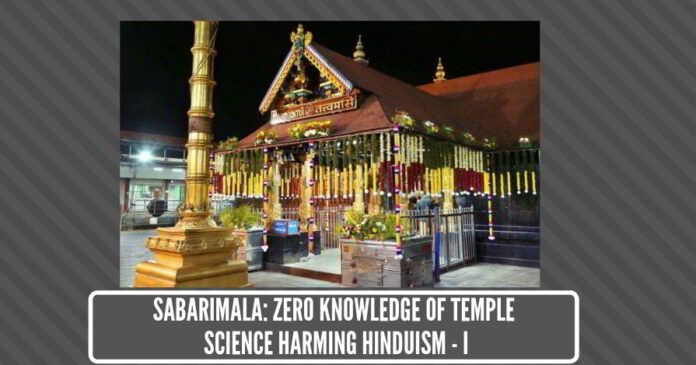
Temple is the house of God established with rules & regulations aimed at giving certain benefits to not just the devotee but to everyone in the vicinity
With the hearing of the review petitions on Sabarimala due to commence, the restriction on women of menstruating age is once again going to come under the scanner. Also in focus will be the ‘right to pray’, gender equality and non–discrimination owing to biological characteristics. No sensible person would deny all these, but in the context of temples of Hindu Gods, there is something that people do not seem to know.
According to Hindu Thought, there is one God – the all-pervading, the all-knowing and Infinite entity
Temples are houses of Gods established with certain rules and regulations aimed at giving certain benefits to not just the devotee but to everyone in the vicinity. The extensive Vaastu rules on the construction of temples and different worship methods for different temples are the foremost indicators that there is something more than what is seen outwardly. The tragedy of current times is that even Hindus are not aware that temples are meant for reverberating certain benefits for the community at large, while prayer is a mental exercise by a person on the deity of his / her choice. One can pray even without an idol or temple, but the violation of temple rules causes humanity to suffer. In the light modern research on what happens in a temple and on issues surrounding menstruation, we will be discussing here why age-old temple traditions should not be violated. Let us begin with understanding why the temples were established.
Temple as a house
Temples were there even in Vedic times. The rules of building temples given by Varahamihira are attributed to Vedic sages Manu and Garga. Temples are mentioned in Valmiki Ramayana also. Rama too worshipped in a temple. The temple was referred to as ‘Aayatana’ in his times. Valmiki says that Rama and Sita slept in the house of Vishnu on a bed of Kusa grass on the night before the proposed coronation. This might be intended to make them have peaceful sleep, perhaps with pleasant dreams, as there is an injunction in the texts on Svapna-phala (effects of dreams) that those who had a bad dream should sleep in a temple. This shows that the temple environment can calm down a person and give him peaceful sleep or a mind without disturbances.
A temple which calms the mind and helps in contemplation can also cause unwanted effects to a person. Why else are there injunctions in Vaastu texts that no residential house should be built behind or in front of a Shiva or Vishnu temple? Families living in those places are supposed to get dissipated. It is for this reason that roads are found in the four cardinal directions around temples. Similarly, residences within a radius of 200 yards of a temple of Shiva or Vishnu or Shakti of Ganesa are supposed to suffer in specific ways. These kinds of injunctions could not have come into place without some rationale.
However, this stricture does not apply to the community at large living beyond the stipulated distances and directions. This is ascertained from an adage in Tamil that says, “Never live in a place where there is no temple” (Koil illaa ooril kudi irukka vendaam), implying that people would lose protection if they live in a place where there is no temple! This conveys that temples are basically for the welfare of the community. Perhaps keeping this in mind the olden kings of South India established numerous temples, but within the stipulated rules for the benefit of the people.
Forms of the Supreme Being
Worship in a temple is not the same as mental worship of God which can happen at any place. Worship of a deity housed in a temple is the last and fifth form of the Supreme Being among Its five forms available in the cosmos. According to Hindu Thought, there is one God – the all-pervading, the all-knowing and Infinite entity. It is known as Brahman owing to the fact it is ’Brh’ which means huge and that which keeps growing. This all-pervading Entity is manifest in five forms:
(1) Para – the Omni present state
(2) Vyuha – in the state of created Universe
(3) Vibhava – as Avataras in this world
(4) Antaryami – the In-Dweller in every being as “one who controls from inside”
(5) Archa Murthy – as the manifestation in Vigrahas, in temples and in Nature
Depending on the mental evolution, a person can make a connection with any one of these forms or move from one form to another – in a single birth or in a series of births. The ultimate realisation is the form known as Para – the omni present one in which everything abides (Vasudeva sarvam iti: Gita 7-19). This includes one’s own Self (Tat tvam asi) too. Whether this Self becomes one with Brahman or identical to Brahman is a matter of interpretation by different schools of thought, but what cannot be denied is that this Self is in the nature of Brahman and when it Realises this, it gets Liberated from the cycle of rebirth.
The purpose being the same – that of offering certain benefits to the community – it would be interesting to know what exact benefits are drawn from the temples
These five forms can be understood by a comparison with water. Water is the basic necessity of life. Even if there is no food, a person can survive on water. Similarly, a person survives solely on God who is manifest in five forms like how water is manifest in five forms. Water is available in Nature – first as clouds, in oceans, in rivers, in wells and in taps in one’s house.
(1) The water of the clouds cannot be consumed directly to quench thirst. This is comparable to Para manifestation. You realise that Para exists. You realise that Para contains all seeds of water, but it’s beyond your reach.
(2) The water of the ocean cannot be drunk directly, but without oceans, water cycle cannot be sustained. The Vyuha manifestation is similar to this. Without Vyuha manifestation, worlds cannot come into existence and life cannot thrive. It is difficult to use this level of manifestation, but a realisation of this manifestation occurs once a person starts thinking about the way Brahman is manifest.
(3) Rivers go everywhere so that people in different places draw water from them. This is comparable to Avataras of God which continue to exist for all times so that people of different generations draw the essence from them and enrich themselves. The knowledge of avataras and their purpose helps in improving the awareness level of a person on the existence of God on how one has to fashion one’s life to improve oneself.
(4) Water in a well is used by the owner of the well. This is comparable to Antaryami manifestation which is about a close or intimate and one-to-one relationship with God. The all-pervading God becomes a personal God in this level who is recognised as one who resides within oneself. The water analogy also would show how easy it is to draw water from a well which is one’s own. The personal God concept is the easiest way to drink ‘water’ of the Grace of God and mature further towards Realisation of God.
(5) Tap water. The water that descends from the cloud and goes into the ground is drawn by someone else and directed to reach us through the pipelines in such a way that all we have to do is just open the tap and drink water. This is comparable to theVigrahas or idol worship. Idol worship is the easiest way to connect with God and draw His blessings. This is not the lowest form as it is mentioned last, but it is the easiest form in which one can form a connect with God and draw the energy. The water that initially originated in the clouds finally reaches every home and every place in a single home, wherever you want, through taps. That is the benefit of idol worship.
Depending upon the preferences of the house owner, the taps are fixed in his house from which he draws water whenever he wishes. The same rationale is applied to the manifestation of numerous Gods in temples throughout our country. Suppose you have to cross a forest, don’t worry, God is manifest there as Vana Kali to give you protection. Suppose you have to cross a mountain, God is manifest as Muruga to guide you safely. Suppose you have to cross a tough terrain full of dangers, Shiva’s deputies Veera Bhadra or Bhairava would be there to offer you safety.
In this way, many Gods became manifest, each identified with a specific benefit for a community or population in a location. In this way Muttharamman was manifest in coastal regions from whom the pearl divers drew their strength for pearl diving. Maariyamman was manifest wherever a threat of smallpox was felt. Sitalamma was manifest when a threat of an epidemic was seen. Village deities were manifest to protect the villagers and boundary deities (Yellai amman) were manifest to protect the boundary from enemies. The basic nature in all these Gods and Goddesses is that they are easy-to-reach forms of Para – like the availability of water from clouds to taps in your house.
The list of these deities goes endless – in having sprung up in different time periods for different reasons and they include human beings too, who died under duress while protecting someone or an entire community. In all these cases, the deity is given a form called ‘Vigraha’ and housed in a temple.
Vigraha means special embodiment. The root word is ‘graha’ which means ‘to bind’.
The physical form of Vigraha binds some special features – those of God Himself so that it gives many benefits to the people who come to worship it. Rules and regulations do exist on the choice of the place for the temple, the type of building, the material used for making the Vigraha, the concept of the deity and the form of the deity, whether It is single, married or celibate. This is how a temple with a deity has come into existence.
The one commonality in all temples – whether they are tribal or belonging to particular communities or established through Vedic yajnas – is that the worship methods and materials are the same. Water, flowers, fruits, incense and offerings are part of worship in all temples. Even during Ramayana times, the same had existed as we read of Vasishtha calling ‘eligible’ persons (yogya) to gather at temples and road junctions with rice, eatables, presents and garlands. (VR: 2-3-18)
The purpose being the same – that of offering certain benefits to the community – it would be interesting to know what exact benefits are drawn from the temples. There exists just one experiment done on ‘temple science’ till date, though many smaller experiments have been done, but not publicised. A reading of it along with certain other research findings solves the twin puzzle of why women during menstruation stay away from temples and why women of menstruating age stay away from Ayyappa temple at Sabarimala.
Hindus from an undated past had been purifying the air with negative ions in every region with the active participation of everyone in the community.
What happens inside a temple: a scientific revelation
The following report from The Indian Express (December 31, 1980) is about research conducted in a model garbha graha (sanctum sanctorum) by a team of teachers and students from Parasakthi College of Courtallam, Tamilnadu. The findings were displayed in HR and CE stall at the Tourist Trade Fair held at Chennai then:
“Teachers and students of Parasakthi College, Courtallam, through a set of experiments using laboratory gadgets, make a scientific interpretation of the chanting of slokas, abhisheka of the idol and offering of fruits and leaves. ‘Temple worship has definite scientific reasoning behind it’, the assistant professor in charge said.
First, it is explained how there is a proportionate configuration to the sanctum sanctorum and the idol it houses – the sanctorum is structured in such a way that the idol in it reflects any sound wave to the maximum effect. A tuning fork is vibrated in the hall with little sound reproduction, but when it is struck and placed before the entrance of a small model sanctorum, a loud hum is heard. The forks invariably produce a sound resembling the chant ‘OM’.
The lecturer explained that among the various chants, “OM” had the largest resonant effect and displaced a sizeable amount of atmosphere inside the sanctum. This is possible only when the sanctum and the idol are made of granite.
Next, it is explained how the presence of negative ions increases in moist condition, rather in dry condition using a condenser to infer why the sanctum sanctorum is always kept moist by pouring water over the idol and washing it with water continuously. Similarly, the conduction of the stone idol also increases when it is moist – this is demonstrated by comparing the conductivity of dry granite and that of a wet idol.
The materials used for the abhisheka of the idol increases the conductivity of the stone through their own pH values. pH value of a substance is the negative concentration of the ion it possesses. Most of the materials used for abhisheka – milk, curd, sandal paste, turmeric powder, vermilion powder, vibuthi have high pH values, a simple chemical experiment shows. And when they are poured over the idol they increase the conductivity of the idol, also ionizing it.
A resistance reading on the ohmmeter of the idol after these elements have been poured shows the increased conductivity of the idol. The chanting of the mantras and the more frequent “OM” sets the air column inside vibrating and the highly sensitized idol conducts the ions of the abhisheka substance to the moist atmosphere. The lighting of camphor during the deep-aradhna displaces the air, which is partially charged with ions, and the devotees inside the sanctum inhale these ions. These negative ions have the physiological function of fixing oxygen with haemoglobin in the blood, the lecturer explained. They are concentrated on beach shores and mountaintops in the early morning, which explains a doctor’s advice to heart patients for early morning beach walks.
In the final inference, it is explained, a devotee’s presence in the sanctum during abhisheka helps his system induct more negative ions than he usually inhales. A visit to the temple is a good substitute for the morning walk, the lecturer explained, and a tonic for good health. But with temples becoming overcrowded, it would not be a wonder if these negative ions are submerged by the excessive carbon dioxide exhaled in the packed sanctum which is meant to house only ten people at a time. Similarly, the chanting of “OM” has also been reduced to a mere inaudible mumble, affecting its highly resonant quality”.
The final inference boils down to just one factor – the generation of negative ions (anions). This has a direct correlation with a higher pH value of the substances used in abhisheka and puja inside the temple. The pH value refers to two extremities with the higher pH value referring to more alkalinity and lower pH value referring to more acidity. This experiment shows that temple worship conducted every day with six-time puja in bigger temples and one to three-time puja in all temples is continuously churning out negative ions much like the air purifiers in pollution-bound areas. With the rise in pollution levels, people are nowadays buying and installing air purifiers in cities like Mumbai and Delhi, but Hindus from an undated past had been purifying the air with negative ions in every region with the active participation of everyone in the community.
To be continued…
Note:
1. The views expressed here are those of the author and do not necessarily represent or reflect the views of PGurus.
- Was Taj Mahal a Hindu temple or a palace or part of a twin temple? - November 13, 2023
- Does Agnihotra Homa offer protection from Corona Virus? - March 21, 2020
- Kejriwal owes his victory to MK Formula – the Coronavirus of Democracy! - February 14, 2020











[…] Sabarimala: Zero knowledge of temple: Science harming Hinduism – I 2. Sabarimala: Zero knowledge of temple: Science harming Hinduism – […]
[…] 1 of this series can be ‘accessed ‘ here. This is Part […]
Excellent article.
Temples and Temple vidhi ‘science’ needs to be promoted.
Its similar to and much better than going to ‘ counselling’ , Whatsapp groups , a ‘personal trainer’ and other new fads.
Modern science /technology is ok in measured amounts , if possible.
Fantastisc Article,
The analogy on Five Forms of all-pervading Entity with the Five Forms of Water , is the best one.
Our Nation’s “Air Purifiers” are our Temples itself. I was thrilled to know about this.
Thanks a lot.
One uses Calculus to expound certain truths which need such a profound mathematical tool to be explained and understood. Not all truths require a sophisticated tool like calculus. Almost all situations in life can be explained using arithmetic or simple algebra at the most. Ability to use Calculus to unravel phenomena does not mean one has no proficiency for dealing with situations effectively using Arithmetic or Algebra. However if one is only adept at arithmetic or at best simple algebra, there is a difficulty when it comes to dealing with phenomena which indeed requires Calculus to understand. As calculus is not everybody’s cup of tea, people reconcile with simplifying the worldview to be able to fit into Arithmetic and just discard, deny or put under the carpet phenomena that can be explained only through Calculus. And if those with Arithmetic world view become dominant, their discard and denial about the legitimacy of the need for calculus can be discarded with disdain and authority.
Hinduism uses all tools equivalent to Arithmetic right up to Calculus in the religion/spiritual arena. Abrahamic religions are made with simple Arithmetic worldview. Indian laws and constitution, having its colonial origin, do not use anything more than Arithmetic worldview. Our SC which is the final arbiter on the interpretation of the constitution, used to attempt at least some simple algebraic tools in the past but now with left-liberal psyche dominant among the SC judges who are more Abrahamic in mental orientation than even the Christian or Muslim nations, find it extremely disconcerting trying to take any step beyond Arithmetic level. And being powerful they discard anything more sophisticated with disdain. This explains the struggle of Hindus in trying to drill into the dogmatic heads of “me Lords” phenomena like temples and deity and we end up with anti-Hindu judgments like the Sabarimala temple case.
Hindus must first get educated and then Hindus must reform the “Melords”. This piece below is a good one in that direction. The first part of the series:
Nice article mam
Dr Jayasree Saranathan, thanks for your article.
In our country every village or a town is bestowed with a temple and a village devata/presiding deity named after the significance of that place/ancient occurrence of miracle or warding off certain diseases.Every temple parikrama used to uphold the culture of our Sanatana Dharma. You have perfectly quoted “Koil illaa ooril kudi irukka vendaam” still a time tested dictum.
Even in traditional families women during menstruation, do not touch or enter pooja rooms and stay away from daily ritual.
In many temples in our country we see Vigrahams swayambhu/self originated / chiselled on a fine textured Granite/Gneiss, or a sandstone or khondalite, Charnockite, fine crystalline basalt in other words ancient people used locally available stones. Majority of the ancient temples in India and neighboring countries are “energy centers” and connected with Planetary System also.
During Ramayana and Mahabharata times we often come across reference on “osmium” imported from interplanetary sources to manufacture weapons.
Water really plays an important role in all rituals.Our rishis and munis used to go thru a tunnels on their own “mano vegam” to dip in Ganges or some nearby rivers before starting their before sun rise chores. I came thru one such tunnel (now closed) located on the Ananthagiri Hilly forests -Ananthagiri Padmanabha temple (70 Kms from Hyderabad Telangana state) leading to Patna, in Bihar state!!
“Temple science” can be given importance and prominence provided we disarm state governments/local governments dominating them and ruining sanatana dharma while allocating funds for renovation of other religious faiths structures under secularism umbrella!!
The article is good and readable. There is one point, which is outside the purview of the issues discussed in this article which is important with respect to issues raised visa vis Sangrampur and Sabarimala by the likes of Prachi Desai and co. As far the fundamental right of equality is concerned it would come in only if say, the State makes a law or lays down rules prohibiting women or fertile women – as the case may be – from worshipping God Sani or Lord Aiyyappan. However it does not attract the chapter of Fundamental Rights if a private temple, in its tradition, has such restrictions. If it is a State co stricted and run temple the Fundamental Rights will come in. But if the State takes over the management of such stemple in the public interest or provides substantial services and facilities because large numbers visit those temples, the private nature of the rules and customs will still prevail. There are SC judgements that an organisation can be State for some purposes and not State for others simultaneously. The Justice Thomas judgement, I believe, is a leading judgement in this area. It held the Andhra Pradesh Road Transport Corporation is State for many purposes such as the protection its employees have as Public Servants and not State for the purposes of the Income Tax Act. I am writing this to draw attention to the fact that it appears that this argument has not been effectively out across to the SC in these cases